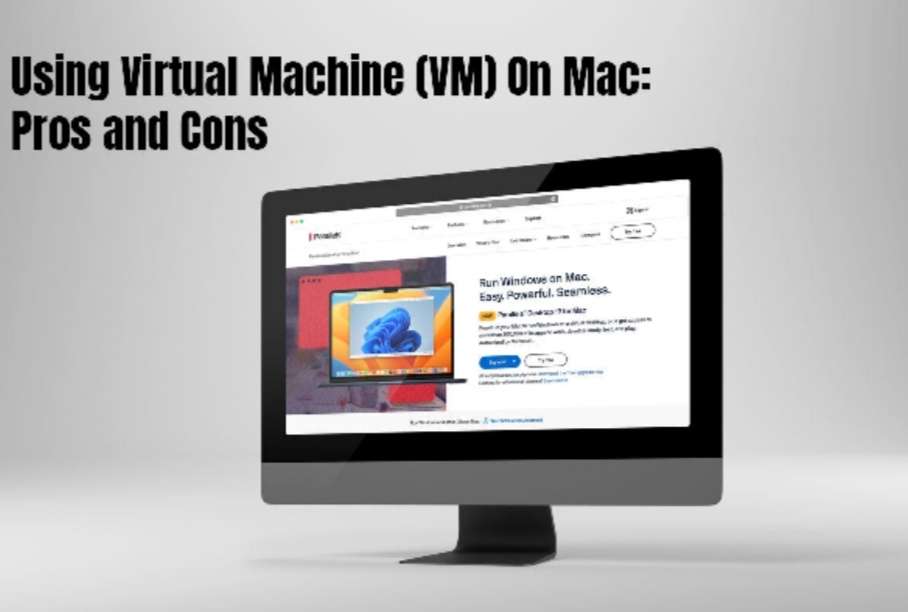The world of computing is ever-evolving, and one tool that has emerged as the most versatile and powerful for Mac users is VM or Virtual Machine. Before heading headfirst into adding it to your Mac arsenal, let’s understand what VM means and weigh its pros and cons.
What is a Virtual Machine (VM)?
A VM is a program that runs isolated computing environments, such as a Windows or Linux operating system, on top of another hardware or operating system.
For instance, you can run Windows on your Mac device or run an old version of a Mac application on your current macOS version using a Virtual Machine.
The Virtual Machine you run on your Mac device is a separate program. Hence, whatever you do on it won’t affect the host operating system. For example, if the virtual machine is infected with a virus, it will not impact your Mac.
Moreover, it is possible to run multiple virtual machines on your Mac, but doing so will result in unstable and sluggish performance.
Having trustworthy VM software so you can switch to a different computing environment whenever you want is a significant advantage. If you are seeking the best virtualization software for Mac, some standout options are Parallels Desktop, VMWare Fusion, Apple Boot Camp, QEMU, Oracle VM VirtualBox, Citrix Hypervisor, and Wine 4.1.
The Pros of Using Virtualization Software
- Improved productivity
One of the main benefits of using virtualization software on Mac is productivity because it allows you to run both macOS and Windows simultaneously. So, you can easily switch between the two operating systems without closing programs or shutting down. It saves a lot of time and resources by allowing you to access programs and applications compatible with these systems.
- Running multiple operating systems
Mac devices are known for their performance and speed, but many professionals continue to prefer using Windows because several professional applications are unavailable on macOS. This problem is solved by virtualization software. Users can utilize these Windows-specific applications on their Mac without having to purchase a separate Windows machine.
Besides professions, gamers prefer using VM to run Windows-only game titles on their Mac computers.
- Enhanced efficiency
Using a VM means boosting your workflow efficiency because you don’t have to partition your hard drive or even configure boot camp. VMs run independently of the physical machine.
Moreover, virtualization software performs at full capacity because native drivers accelerate the virtual components. This enables you to run performance and graphics-intensive programs smoothly.
- Economical
Using a single physical server to host several virtual machines is an economical choice because it saves hardware costs. You can further reduce the cost by using affordable hardware for virtual machines.
- Portability
You can easily move virtual machines or physical machines between different cloud environments. This empowers you with improved flexibility in terms of scaling and deployment.
You can easily back up the virtual machines and restore them in cloud environments or local machines. This allows for faster recovery if there’s a system failure or any other problem.
The Cons of Using Virtualization Software
- Complexity
One of the reasons why many users steer clear of virtualization software is that they are not the easiest to set up and manage. If you are not familiar with server administration, it will be difficult for you to navigate the installation and configuration process. Also, managing multiple virtual machines is no mean task. It is difficult and time-consuming.
- Demands a lot of resources
VMs are resource-intensive, and this is one of its biggest drawbacks. Running two operating systems simultaneously means it requires a lot of storage space, processor power, and memory. It may slow down the host computer and ultimately impact the performance of the virtual operating system.
- The user experience is limited
Although you can run Windows-only applications on your Mac by using virtualization software, you will not get the full Windows experience. Some of the applications may run incorrectly or be unavailable on the VM. You may have to restart your system several times to free up resources.
- Security issues
Not always, but there are instances where malware or viruses on virtual machines have infected the host computer. Also, if the Virtual Machine is hacked, the hackers might be able to steal the confidential files and data on your host and virtual machine.
- License issues
Users have complained of license issues when using virtualization software. You may have to purchase separate licenses for each of the machines. Also, some software licenses may stop you from running the software on a VM.
The Bottom Line
Using virtualization software on Mac is an excellent way of running multiple operating systems simultaneously or even older versions of macOS applications. However, you have to take into consideration the potential drawbacks of using a VM before making your choice.
Read More: DesarrolladorSoft Expertise: Elevating Your Business through Advanced Software



